
This 1-Ingredient Gluten-Free Buckwheat Bread recipe is an absolute game-changer! I’ve been making it every single week since early 2022, and it never disappoints! It’s incredibly easy, delicious, and super nourishing. I highly recommend throwing a couple of slices in the toaster/oven to create the ultimate avocado toast or as a side dish for dipping into soup. It even makes amazing croutons in a salad!
Since sharing this recipe with our community on social media, it’s become one of our most popular recipes to date. Hundreds of our community members have shared their versions with us on Instagram. Check out our Buckwheat Bread Instagram Highlights to see just a sample of the ones we’ve received, and please make sure to share your own! If you’re in interested in more gluten-free bread recipes, you’ll also love this super fluffy Red Lentil Quinoa Bread!

Ingredient Notes
- Hulled Raw Buckwheat: Buckwheat groats (or kernels) are the hulled seeds of the buckwheat plant. Despite their name containing the word “wheat,” buckwheat is actually gluten-free and makes for a fantastic bread ingredient. These groats are a staple in many Eastern European and Asian cuisines, known for their nutty flavor and versatile use. This Healthy Buckwheat Bread Recipe is a testament to that.
- Water: Tap water is fine to use depending on your location, if the water is heavily chlorinated in your area, you should choose filtered water, as chlorine will impact the fermentation.
- Salt: Either sea salt flakes or table salt works fine. The salt enhances the natural flavor of the buckwheat.
- Poppy and Sesame Seeds: Adds a delightful crunch and visual appeal to the bread. They are optional but highly recommended for an extra touch of flavor and texture. You can top it with any seeds you like.
IMPORTANT: Use ONLY hulled, non-roasted buckwheat for this recipe. Buckwheat flour, unhulled buckwheat, activated buckwheat, or roasted buckwheat will not work in this recipe.
Why You’ll Love This 1-Ingredient Buckwheat Bread Recipe
- Delicious and Dense: It’s absolutely delicious, with a dense, satisfying texture, and gets even better when toasted! Fermentation not only enhances the flavor, but it can improve the bioavailability of certain nutrients in foods. Specifically, the fermentation process can reduce levels of phytic acid, which is known to bind some minerals and reduce their absorption. By breaking down phytic acid, fermentation can make minerals like iron, zinc, and magnesium more available for absorption by the body.
- So Easy: Although the fermentation process takes a bit of time, this recipe is very hands-off and only requires about 10 minutes of actual work. If you use the right kind of buckwheat, a high-speed blender, and follow the instructions, this simple, yeast-free bread recipe is practically foolproof.
- Cost-effective: Good quality, nourishing, gluten-free bread can be quite expensive where we live, often costing around $15 AUD (~ $9.80 USD), whereas this Gluten-Free Buckwheat Bread comes in at under $3.50 AUD (~ $2.30 USD), even when using organic hulled buckwheat.
- Meal-Prep: Easy to prep in advance and can be frozen. I usually keep half fresh, wrapped in a clean kitchen cloth, to consume in the next few days and slice and freeze the rest. Toast when ready to eat, and it’s as good as fresh! This way, you can toast a piece whenever you crave some delicious bread.
What Are the Health Benefits of Buckwheat?
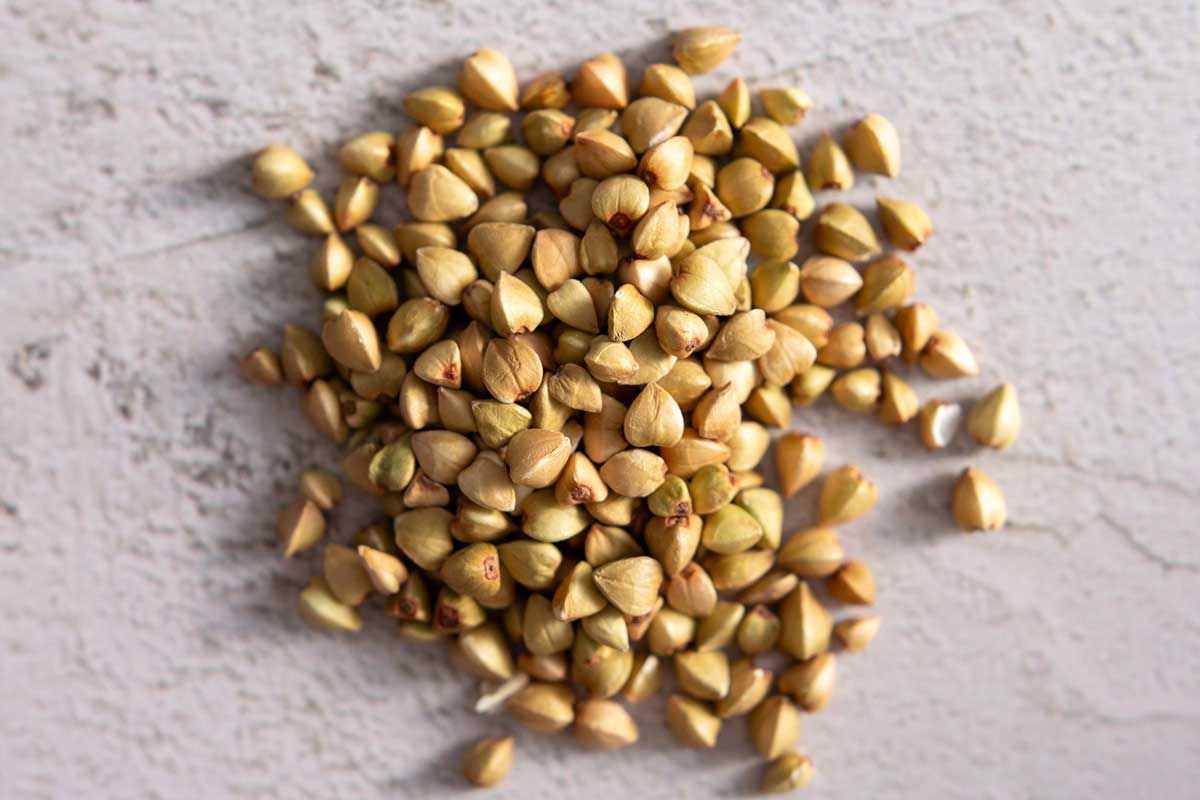
- Buckwheat is highly nutritious, offering a source of fiber and essential minerals, especially magnesium. It’s also packed with antioxidants, particularly rutin, which supports blood vessel health. Despite its name, buckwheat is naturally gluten-free, making it suitable for those with gluten intolerance or celiac disease.
- Buckwheat’s low to medium glycemic index makes it a good choice for those managing blood sugar levels. Plus, its high fiber content aids in digestion.
- Like amaranth or quinoa, these whole grain groats can be cooked like rice or oats, making them a fantastic ingredient for various dishes. From traditional porridge and pilafs to modern salads and even as a rice substitute, buckwheat is incredibly adaptable. It’s also used in making buckwheat flour, a popular alternative for gluten-free baking. We use buckwheat flour to make these High-Protein Buckwheat Pancakes with Blueberry Syrup, and they’re so fluffy and delicious!
Step-by-Step Instructions
Rinse the hulled buckwheat kernels under cold water until clear. After rinsing, soak 17.5 oz (2.6 cups or 500g) of buckwheat in cold water in a large bowl, fully submerged, and cover with a clean cloth for 6 to 7 hours.
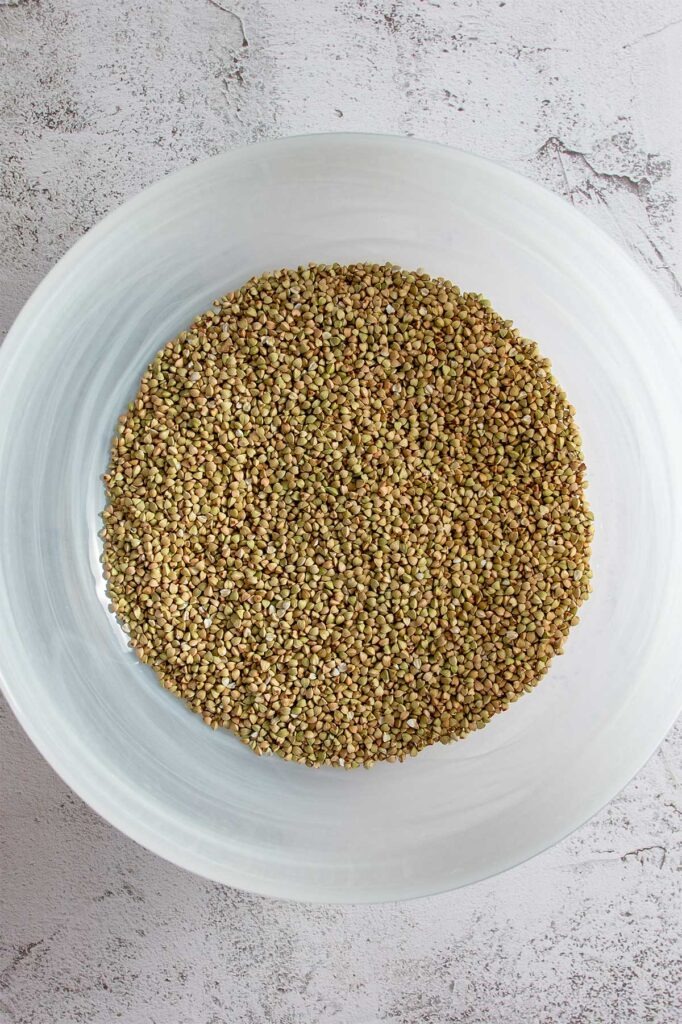

Once soaked, drain the remaining water, but do not rinse.


Transfer to a blender with 6.8 fl oz (0.9 cups or 200 ml) of water and ¼ tsp salt. Blend, starting at low speed and slowly increasing, until you get a very smooth texture without any pieces left. Pour the blended buckwheat mixture back into the bowl.
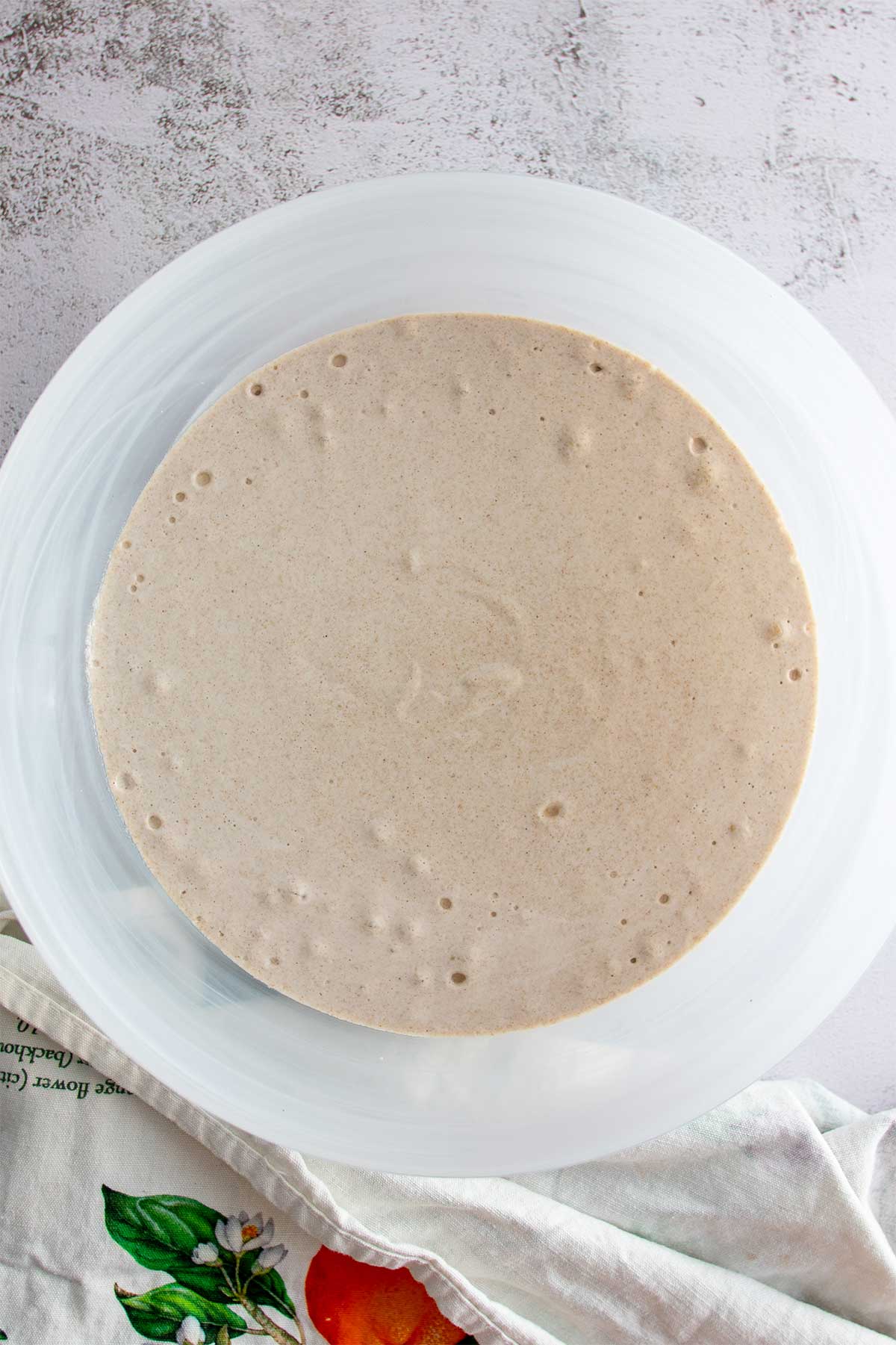
Cover it again and let it sit at room temperature for 12 to 24 hours to ferment. Please check the fermentation table below to confirm the time required based on your current climate.
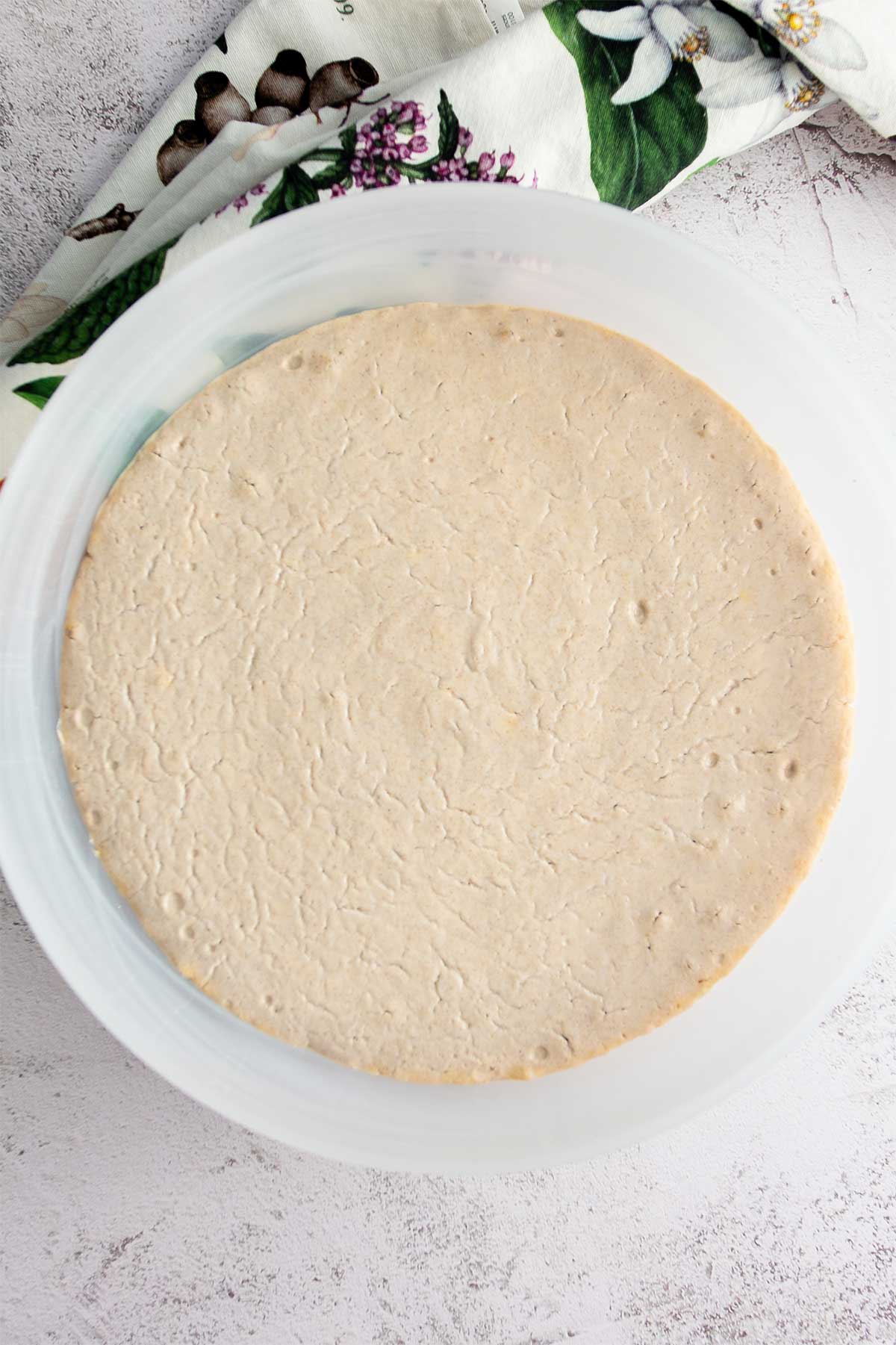

When you’re ready to bake, preheat your oven to 350°F. Line a loaf pan with baking paper and pour the fermented buckwheat dough into the pan. If you’d like, sprinkle the top with 2 tsp of poppy and sesame seeds (or whichever toppings you’d like).


Bake the bread in the preheated oven for 90 minutes. The bread should be golden brown and firm to the touch.


Allow the bread to cool down before slicing. This makes it easier to cut and improves the texture. Enjoy your homemade, nourishing, gluten-free buckwheat bread!


How Long to Ferment Your Buckwheat Bread Based on Your Current Climate
🌨️ Colder (Winter)
Indoor temperature range: ~70°F (20°C)
Soak: 6–7 hours
Fermentation time: Up to 24 hours
Note: If the temperature is lower than 70°F (20°C), place the bread in a warm spot or near a gentle heat source to help it ferment.
☀️ Warm (Summer)
Indoor temperature range: 75–85°F (25–30°C)
Soak: 6–7 hours
Fermentation time: Around 12 hours
Note: A warm environment speeds up fermentation, so check the texture after 10–12 hours.
🔥 Very Hot
Indoor temperature range: Above 85°F (30°C)
Soak: 6 hours
Fermentation time: As little as 6 hours
Note: The hotter it is, the less time needed. In extreme heat, soak the buckwheat in the fridge for 6 hours only.

1-Ingredient Buckwheat Bread (Nourishing and GF)
Equipment
Ingredients
- 17.6 oz (500 g) hulled buckwheat kernels (2.6 cups) - MUST be hulled, raw buckwheat kernels/groats for this recipe to work
- 6.8 fl oz (200 ml) water (0.9 cups)
- ¼ tsp (1.5 g) sea salt flakes
- 2 tsp (4 g) poppy and sesame seeds - optional
Instructions
- Rinse the hulled raw buckwheat kernels under cold water until the water runs clear. This ensures that any dust or impurities are removed.
- Transfer the rinsed buckwheat to a large bowl. Cover the kernels with a large volume of cold water, ensuring they are fully submerged. Cover the bowl with a clean cloth and let it sit for 6 to 7 hours.
- Once soaked, drain the water, but do not rinse the buckwheat kernels. Transfer them to a blender with 6.8 fl oz (0.9 cups/200 ml) water and the salt. Blend, starting at low speed and slowly increasing until you get a very smooth texture without any bits and pieces of buckwheat remaining.
- Pour the blended buckwheat batter back into the bowl. Cover it again and let it sit at room temperature for 12 to 24 hours (please see notes to determine how long you should leave it to ferment based on your climate). Once fermented, you will notice a very slight rise, and the mixture should be slightly bubbly inside.
- When you're ready to bake, preheat your oven to 350 °F. While the oven is heating, prepare a loaf pan by lining it with baking paper.
- Pour the fermented buckwheat dough into the prepared loaf pan. If using, sprinkle the top with poppy and sesame seeds.
- Bake the bread in the preheated oven for 90 minutes.
- Remove the bread from the loaf pan and let it cool completely before slicing. This is important to get the best texture. Now, enjoy your homemade, healthy buckwheat bread!
Video
FAQ
This depends on your location and current temperature, as fermentation is temperature-dependent. Colder climates will need a longer fermentation, and it can be shortened as the temperatures rise during the year, as the heat accelerates fermentation.
For colder climates (winter, with an indoor temperature of approximately 70°F (20°C)), ferment for 24 hours. If your indoor temperature is below 70°F (20°C), you can try leaving the batter in the warmest place in your house to give it the best chance of fermenting.
For warmer climates (summer with an indoor temperature between 75 – 85°F (25 – 30°C), I’d recommend starting with 12 hours of fermentation. We have tested this recipe in both summer and winter in Sydney Australia, which remains a pretty temperate climate. Depending on where you are in the world there might be a little bit of experimenting to figure out the perfect timing, but I promise it’s well worth it!
Some people from our IG community in more exotic locations with hotter and more humid climates have reported good results with as little as 6 hours of fermentation. If this is the case for you, start with 6 hours of fermentation and monitor the dough to avoid over-fermenting. The dough will have a slightly raised appearance and be a little bubbly inside when ready to eat.
Yes, fermentation does have a specific smell, which will be reduced when baking. Over soaking the buckwhat will result in a unpleasant smell, so keep it to 6-7 hours soaking time on the kitchen counter or in the fridge for extremely hot and humid climate.
Yes, it’s completely gluten-free.
This recipe only works with HULLED, NON-ROASTED buckwheat groats.
Unfortunately, it won’t work for this recipe.
It stays fresh for up to 3 days in a sealed container or wrapped in a kitchen cloth. I like to slice half straight away and freeze it to make the most of it.
Yes, slice and freeze for up to a month.
While the base recipe only requires one ingredient and cannot be swapped, you can certainly add other ingredients to customize the bread to your liking. Consider adding seeds, nuts, dried fruits such as dates, or spices for additional flavor and texture. I love a mix of black olives (pitted!), rosemary, and walnuts! Just remember to add these extras after the fermentation process and before baking. I however recommend tasting the bread without any ad-ons first, to make sure you have the perfect fermentation time, and know what to expect in terms of taste and consistency. Then, feel free to experiment with these additional ingredients to achieve your desired balance of flavor and texture.
You can; it will still work, but I find it provides a much-needed touch to the flavor of the bread.
It has a very slight rise – it’s quite different from yeast fermentation. Don’t worry if it looks like your dough hasn’t risen much – it will still work.
If that’s the case, I would recommend rinsing the buckwheat as it might develop a bit of a smell otherwise. It’s still fine to consume. We recommend not to rinse in our recipe, as when we tested it, we got a slightly nicer texture once baked, but it still worked when rinsed.
They are fine to leave on the counter. However, if it’s too hot or humid where you are, you can place them in the fridge. Leave out of the fridge for the fermentation part.
If you slice it before it cools down, it will just have a mushier texture.
If your indoor temperature is lower than the one we have mentioned, it might need to be fermented longer. Use filtered water if the water in your area contains a lot of chlorine, as this will negatively impact fermentation. Someone in the community also mentioned fermenting the dough directly in the loaf pan as a tip to get it to rise even more.


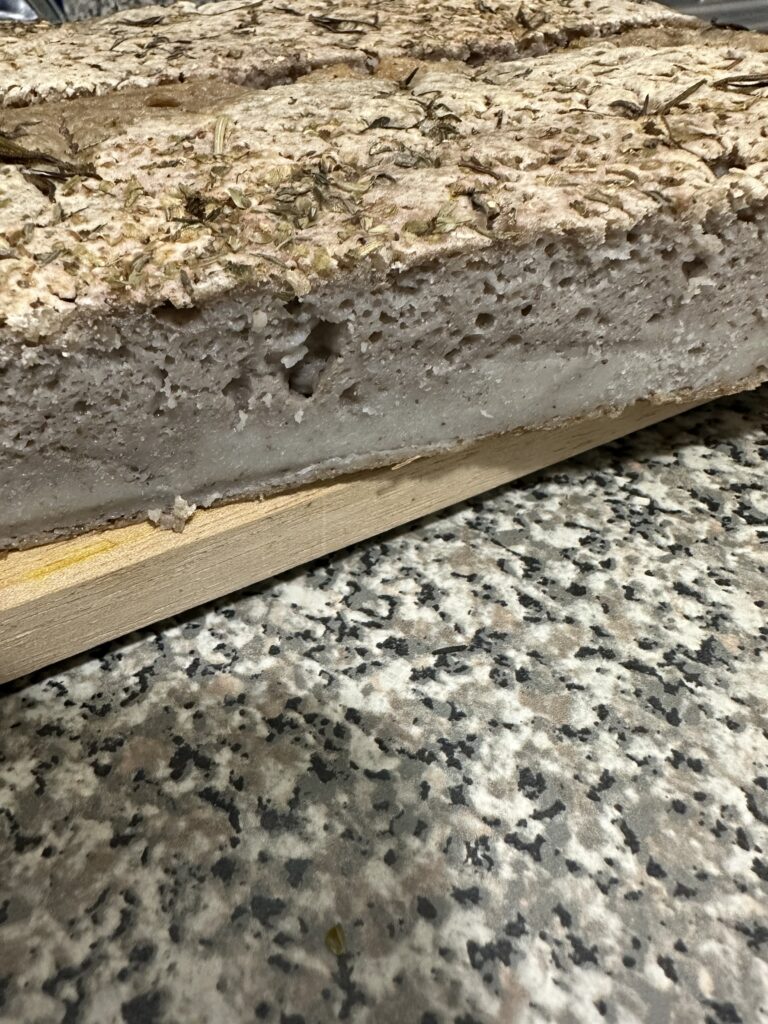
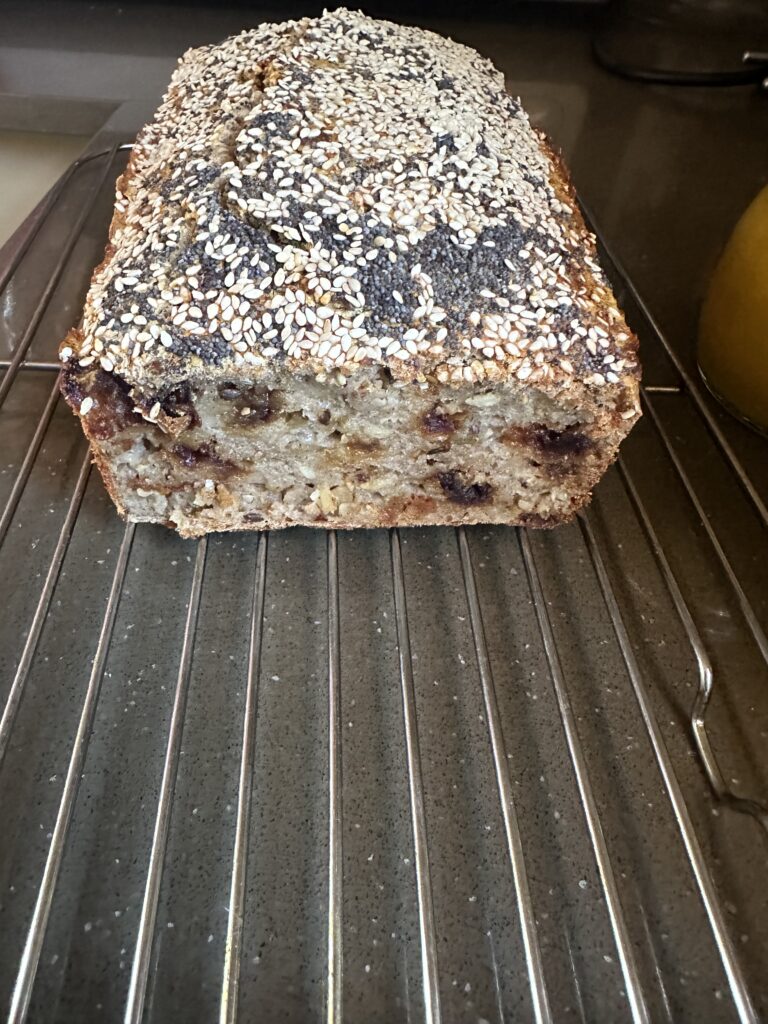








I love this recipe! Thank you so much. First time my toddler has ever eaten bread which is a huge deal for us! Two questions. Should the knife come out clean when it’s done baking? And my paper stuck and I lost most of the bottom crust. Any tips? Thanks!!
Oh I’m so happy to hear that! Thanks for sharing 😍 Make sure the loaf has cooled down before slicing, otherwise it might still look quite wet. I have not encounter this issue with the baker paper, but maybe a little spray of olive oil on the paper, before pouring the batter will prevent it 👀
Thanks for this tip. I just got my first loaf out of the oven. The crust looks amazing, but the knife seems wet fingers, fingers crossed for a bit drier when it has cooled.
Thankyou for sharing your recipe x
Thank you for sharing this 🙏 been looking for a simple bread recipe and the fact that it’s gluten free with buckwheat is the flour on top 🙌
I’m so happy you like it!
Hi Sarah.
How can I know when fermentation is completed? Will it be intensive smell or just little bit? I am not sure if I’ve done it right. I am worried that fermented too long.
Thanks,
Edyta
There is a slight smell, but it will go down when baking 🙂
I let this ferment for 24 hrs and then realized I never added the salt 🙁 just added some and going to let it sit for another hour to see if anything happens….
How did you go?
I baked the bread today. It’s delicious. Thank you for sharing the recipe.
One quick question, outside was hard and properly baked but the inside was wet and dense. I baked for 90 mins. Should I have baked for longer to get the inside dry as well?
I’m so happy you liked it! Make sure to wait until the loaf has cool down before slicing, it will look quite wet otherwise. If you did wait until it cooled down, maybe try cooking a little longer, all ovens are a bit different 🙂
Silly question, but has anyone made this converting to US cups? I’m getting slightly different conversions for the 500 grams of buckwheat and want to ensure I get it right the first time. Thanks in advance!
Not silly at all! I’ve just updated it on the recipe card and measured it, as roasted and non roasted get slightly different weights. We get 2.6 cups for the buckwheat and 0.9cups of water. Hope you love the bread 💚
Thank you so much! Super excited to start making this tomorrow!
Also needing to convert! His much water? I got one cup, but not sure I did it right
It’s 500g buckwheat and 200ml water, if you check just above the ingredient list for all our recipes, you will be able to select “metric” to get the ingredients in grams 🙂 hope you love it!
Thank you! I did make it, but let it soak too long (forgot to drain before bed). Definitely going to make another loaf to try! Also, where’s your favorite place to buy organic buckwheat?
If you’re in Aus, I get big 5 kilos back from Honest to goodness, otherwise Harris Farms sells 500g bags, I believe the brand is Chef Choice, or something similar 🙂
can i use buckwheat flour? if so, i add same amount of water mentioned in the recipe and blend it?
Unfortunately buckwheat flour won’t work for this, but we are working on a recipe using flour 🙂
I just saw this on Instagram and wanted to try it. What temperature do you bake it at and for how long? Also does anyone have the measurements in cups?
Hey lovely, I’ve updated the recipe card to show US cups measurements, it’s 2.6cups for the buckwheat, and 0.9 cup for the water. It bakes at 350F for 90 minutes. Hope you love the bread 💚
Can you please clarify warm and cold to you? I live north of Brisbane so it’s very warm outside, but the kitchen is always 24 degrees with air con. Would 24 degrees warrant a 24 hour fermentation?
Right now in Brisbane I would go with the half fermentation time and start at 12 hours 🙂
I saw the notes. However, when do we know the fermenting is done? Bubbles? Heat? Smell?
This is different from a yeast fermentation, and you will only notice a very slight rise 🙂
yes it worked thank you this is my first time to your lovely site and my first recipe.
does salt slow down the fermentation I would like to add a little more
blessings
Gabrielle
It should be fine to add more salt 🙂
I’m sorry, I’m in the US and I use volume measures. When I looked for conversion from grams, options were to volume or weight. Which do you use, a weight of 500 grams or a volume of 500 grams? Thank you, I am really looking forward to trying this!
Hey lovely, I’ve updated the recipe card to show US cups measurements, it’s 2.6cups for the buckwheat, and 0.9 cup for the water. Hope you love the bread 💚
I have made this twice. Both times the flavor was fantastic, hearty and nice crust. The first time, I soaked for 7 hours, fermented for 14 hours, and cut it after 1 hour of rest. The texture was ok. The second time I made it was incredible. I soaked for 7 hours, used a full teaspoon of salt, fermented for 24 hours in the loaf tin. I was amazed how much it had risen when I went to bake. After baking 90 mins, I let it rest overnight for the most delicious, fluffy, flavorful bread the next morning. I’m in Northern California, approx 45-60 degrees outside and 72 inside. No smell issues fermenting for 24 hours, just great results. However, my loaf isn’t beautiful, the top flattens and caves a bit. Any advice to make this delicious loaf prettier?
So happy to hear that, and thanks for sharing your experience with us 💚 Could it be the size of your loaf pan, is a bit larger than ours? I’ve linked the one we used in the instructions 🙂
I have made this twice. Both times the flavor was fantastic, hearty and a nice crust. The first time, I soaked for 7 hours, fermented for 14 hours, and cut it after 1 hour of rest. The texture was ok. The second time I made it was incredible. I soaked for 7 hours, used a full teaspoon of salt, fermented for 24 hours in the loaf tin. I was amazed how much it had risen when I went to bake. After baking 90 mins, I let it rest overnight for the most delicious, fluffy, flavorful bread the next morning. I’m in Northern California, approx 45-60 degrees outside and 72 inside. No smell issues fermenting for 24 hours, just great results. However, my loaf isn’t beautiful, the top flattens and caves a bit. Any advice to make this delicious loaf prettier?
Hello,
I would have 2 questions:
1. My blender is too small for the amount of buckwheat. Can I use a vertical blender for soups or a multifunctional robot ( which I’m not sure would “break” the kernels) ?
2. The tray must be in the middle of the oven at about 180°C or a bit lower?
Thank you for your reply
I don’t think a robot would make the batter smooth enough, it needs to be completely blended (no little pieces left). In the middle of the oven, hope this helps 🙂
I made it the first time – and it came out quite edible and flavorful. The scent it earthy and fresh. I did not grind down the groat to complete smoothness – my processor just would not get me there, but fermented for 16 hours at 65ºF. Baked for 90 min, and most of it was really nicely done, except the very bottom center, which was still mushy. So next time I will use a wider pan, and bake it a bit longer.
I seasoned it eever so lightly with a bit of Sage, Rosemary, and Thyme in addition to salt and onion and garlic powders. This will be my go-to bread for a long time. Thank you! <3
I’m so happy you liked it. Your herbs addition sound delicious 🙂
My new favourite bread. Thank you! I made it just as written, as you suggested for the first time. This time I’m making 3 loaves but will be adding a touch more salt, raisins, pumpkin seeds and perhaps a touch of monk fruit.
That’s awesome, so happy you loved it Cassie 💚 Let me know how you go with the additions 😍
Hi Sarah,
I am currently making this bread and hoping it turns out fine 🤞🏻
I read several times, here in the comments and on Instagram that you added indications of fermenting times per climate/temperature but I don’t find them anywhere ? Can you help me?
I live in Paris so the climate is pretty cool at the moment and the dough has now been fermenting for 8 hours. I wonder if I should cook it tonight after 12 hours or wait for tomorrow morning so after 24 hours, that’s a big difference.
Thank you for your help!
Xx
Laurine
Hey Laurine,
The instructions are in the article above the recipe and in the notes under it 🙂 As it’s quite cold in Paris now, I’d go for the full 24 hours. Hope you love it 💛
I am currently in the process of making this and up to the fermentation stage. My batter looks more watery than yours. Is there something I can do to make it less liquidy? Can I add oats into it perhaps? I hope I haven’t ruined the batch.
I have accidentally added more water before and it still worked 🙂 let me know how you go 💚
Hi there, is this oven temperature for conventional oven or fan forced?
Fan forced 🙂
Hi there, is this oven temperature for conventional oven or fan forced? Thanks
Hi Sarah, I live in Hobart and i’ve been making a similar bread but without fermenting. It has included chia, lemon. juice, olive oil and baking powder. I can’t get over how good this tastes with just bw and salt.
The only thing is that I think I soaked in a little too much water and although I did drain it a bit after soaking, when I added another 200ml of water, it seemed too runny. Consequently, it sunk in the middle. I left it fermenting from about 9pm to about 5pm the the following day.
Definitely going to try this again as I want to get an unsunken version next time!